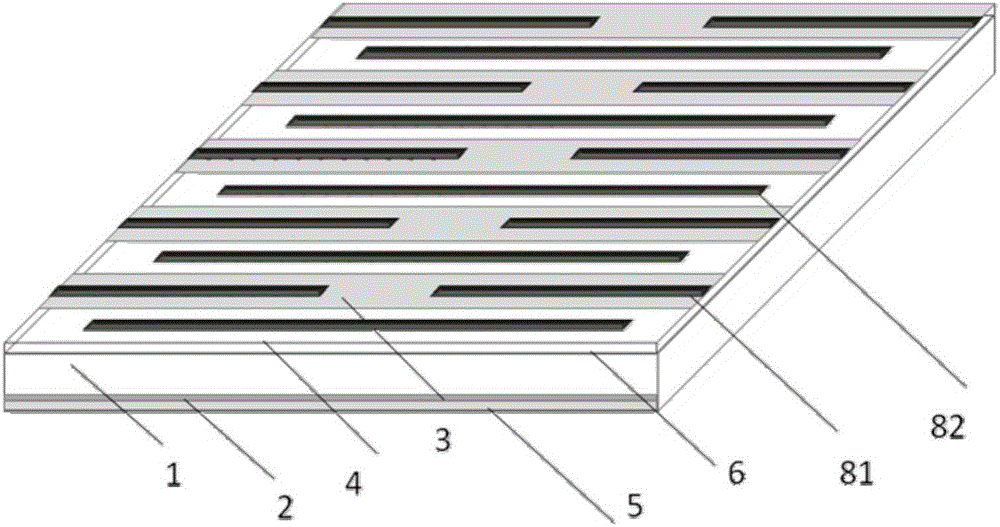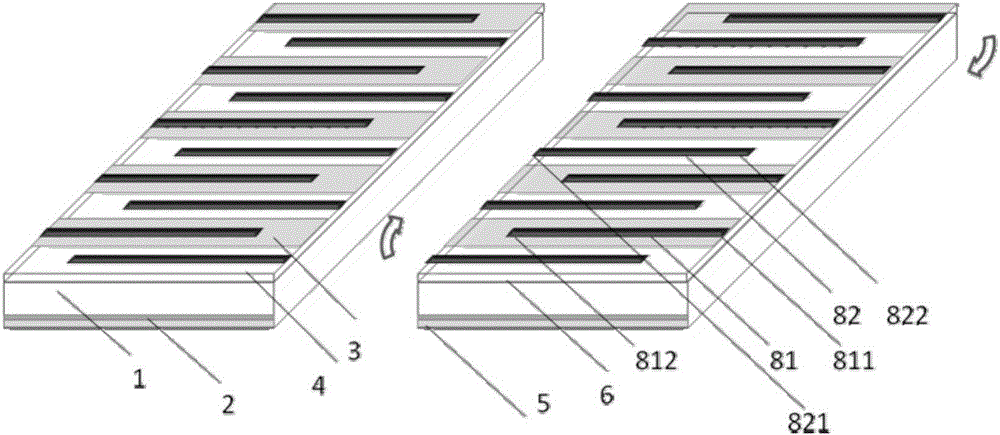Main grid-free full-back contact solar cell module
A solar cell, full-back contact technology, applied in the field of solar cells, can solve the problems of incompatibility, rising cost, and difficulty in collecting holes, and achieve the effects of improving filling factor, reducing resistance loss, and reducing consumption.
- Summary
- Abstract
- Description
- Claims
- Application Information
AI Technical Summary
Problems solved by technology
Method used
Image
Examples
Embodiment 1
[0040] Such as Figure 1-5 As shown, the busbar-less full back contact solar cell assembly provided in this embodiment includes a plurality of back contact small solar cells connected in series, the back contact solar small cells are cut from the back contact solar cells, and the back contact solar cells The small battery sheet includes an n-type silicon substrate 1, on the back of the n-type silicon substrate 1 there are p+ doped regions 3 and n+ doped regions 4 arranged in parallel and alternately, on the p+ doped regions 3 and n+ doped regions 4 A passivation layer 6 is provided, and a positive electrode fine grid 81 is arranged on the passivation layer 6. The positive electrode fine grid 81 is located at the corresponding position of the p+ doped region 3 and is in contact with the p+ doped region 3. A negative electrode fine grid 82 is provided, and the negative electrode fine grid 82 is located at the corresponding position of the n+ doped region 4 and is in contact with...
Embodiment 2
[0063] The difference with embodiment 1 is:
[0064] Such as Figure 6-7 As shown, the protruding end of the negative electrode fine grid of one of the back-contacted small solar cells is connected in series with the protruding end of the positive electrode fine grid of an adjacent back-contacted solar small cell, and the positive electrode fine grid and the The current of the negative electrode fine grid is conducted in the direction of the positive electrode fine grid and the negative electrode fine grid.
[0065] An n+ doped region is provided at the corresponding position where the solder strip is in contact with the silicon substrate on the shortened end side of the positive electrode fine grid of one of the back-contacted small solar cells, and the solder strip is connected to the negative side of the adjacent small solar cell. A p+ doped region is provided at the corresponding position where the silicon substrate on the side of the shortened end of the fine grid of the...
PUM
 Login to View More
Login to View More Abstract
Description
Claims
Application Information
 Login to View More
Login to View More - R&D
- Intellectual Property
- Life Sciences
- Materials
- Tech Scout
- Unparalleled Data Quality
- Higher Quality Content
- 60% Fewer Hallucinations
Browse by: Latest US Patents, China's latest patents, Technical Efficacy Thesaurus, Application Domain, Technology Topic, Popular Technical Reports.
© 2025 PatSnap. All rights reserved.Legal|Privacy policy|Modern Slavery Act Transparency Statement|Sitemap|About US| Contact US: help@patsnap.com



